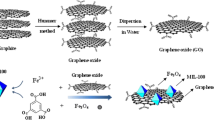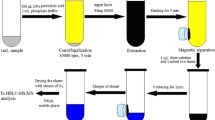Abstract
The development of functional nanocomposites based on covalent organic framework (COF) is still highly important. In this work, a novel COF-functionalized hydrophilic magnetic graphene (magG@PDA@TbBd) was prepared through a facile and efficient route and applied as a unique magnetic solid-phase extraction matrix for phthalate esters analysis. The obtained magG@PDA@TbBd exhibited excellent water dispersibility, large surface area, strong magnetic response, regular mesoporous structure and strong π–π electron system. Based on these properties, the newly prepared composite displayed outstanding reusability and potential performances on phthalates analysis with good linearity (50–8000 ng mL−1) and reliable recoveries (91.4–105.2%). Limit of detection (LOD) varied from 0.004 ng mL−1 to 0.02 ng mL−1, and relative standard deviation (RSD) for intra-day and inter-day were less than 4.4% and 6.7%, respectively. More interestingly, the newly obtained magG@PDA@TbBd was utilized to analyze 9 PAEs in packaged milk samples. This work may open-up a direction in design and construction of functionalized COF-derived composites.







Similar content being viewed by others
References
Wang M, Yang F, Liu L, Cheng CS, Yang YL (2017) Ionic liquid-based surfactant extraction coupled with magnetic dispersive μ-solid phase extraction for the determination of phthalate esters in packaging milk samples by HPLC. Food Anal Methods 10:1745–1754
Eskandarpour N, Sereshti H (2017) Electrospun polycaprolactam-manganese oxide fiber for headspace solid phase microextraction of phthalate esters in water samples. Chemosphere 191:36–43
Dargahi R, Ebrahimzadeh H, Asgharinezhad AA, Hashemzadeh A, Amini MM (2018) Dispersive magnetic solid-phase extraction of phthalate esters from water samples and human plasma based on a nanosorbent composed of MIL-101(Cr) metal–organic framework and magnetite nanoparticles before their determination by GC-MS. J Sep Sci 41:948–957
Yang R, Liu YX, Yan XY, Liu SM (2016) Simultaneous extraction and determination of phthalate esters in aqueous solution by yolk-shell magnetic mesoporous carbon molecularly imprinted composites based on solid-phase extraction coupled with gas chromatography–mass spectrometry. Talanta 161:114–121
Tang M, Wu YF, Deng DL, Wei JY, Zhang JZ, Yang DC, Li GL (2018) Development of an optical fiber immunosensor for the rapid and sensitive detection of phthalate esters. Sens Actuator B 258:304–312
Leng G, Chen WJ, Xu WB, Wang Y (2017) Fully automated vortex-assisted liquid-liquid microextraction coupled to gas chromatography-mass spectrometry for the determination of trace levels of phthalate esters in liquor samples. Food Anal Methods 10:3071–3078
Zhou Q, Zheng Z, Xiao J, Fan H, Yan X (2016) Determination of phthalate esters at trace level from environmental water samples by magnetic solid-phase extraction with Fe@SiO2@polyethyleneimine magnetic nanoparticles as adsorbent prior to high-performance liquid chromatography. Anal Bioanal Chem 408:5211–5220
Chen YS, Cui XP, Wu PP, Jiang ZY, Jiao LY, Hu QQ, Eremin SA, Zhao SQ (2017) Development of a homologous fluorescence polarization immunoassay for diisobutyl phthalate in romaine lettuce. Food Anal Methods 10:449–458
Luks-Betlej K, Popp P, Janoszka B, Paschke H (2001) Solid-phase microextraction of phthalates from water. J Chromatogr A 938:93–101
Xu R, Gao HT, Zhu F, Cao WX, Yan YHM, Zhou X, Xu Q, Ji WL (2016) SPE–UPLC–MS/MS for the determination of phthalate monoesters in rats urine and its application to study the effects of food emulsifier on the bioavailability of priority controlling PAEs. J Chromatogr B 1012–1013:97–105
Qi C, Cai Q, Zhao P, Jia X, Lu N, He L, Hou X (2016) The metal organic framework MIL-101(Cr) as efficient adsorbent in a vortex assisted dispersive solid-phase extraction of imatinib mesylate in rat plasma coupled with ultra-performance liquid chromatography/mass spectrometry: application to a pharmacokinetic study. J Chromatogr A 1449:30–38
Wei XX, Wang YZ, Chen J, Xu PL, Xu W, Ni R, Meng JJ, Zhou YG (2019) Poly(deep eutectic solvent)-functionalized magnetic metal-organic framework composites coupled with solid-phase extraction for the selective separation of cationic dyes. Anal Chim Acta 1056:47–61
Liu SY, Li S, Yang W, Gu F, Xu HY, Wang T, Sun DH, Hou XH (2019) Magnetic nanoparticle of metal-organic framework with core-shell structure as an adsorbent for magnetic solid phase extraction of non-steroidal anti-inflammatory drugs. Talanta 194:514–521
Huang CH, Qiao XZ, Sun WM, Chen H, Chen XY, Zhang L, Wang T (2019) Effective extraction of domoic acid from seafood based on postsynthetic-modified magnetic zeolite imidazolate framework–8 particles. Anal Chem 91:2418–2424
Hunt JR, Doonan CJ, LeVangie JD, Côté AP, Yaghi OM (2008) Reticular synthesis of covalent organic borosilicate frameworks. J Am Chem Soc 130:11872–11873
Li ZT, Zhao WN, Yin CZ, Wei LQ, Wu WT, Hu ZP, Wu MB (2017) Synergistic effects between doped nitrogen and phosphorus in metal-free cathode for zinc-air battery from covalent organic frameworks coated CNT. ACS Appl Mater Interfaces 9:44519–44528
Côté AP, Benin AI, Ockwig NW, O’Keeffe M, Matzger AJ, Yaghi OM (2005) Porous, crystalline, covalent organic frameworks. Science 310:1166–1170
Zhang G, Tsujimoto M, Packwood D, Duong NT, Nishiyama Y, Kadota K, Kitagawa S, Horike S (2018) Construction of a hierarchical architecture of covalent organic frameworks via a postsynthetic approach. J Am Chem Soc 140:2602–2609
Li H, Pan QY, Ma YC, Guan XY, Xue M, Fang QR, Yan YS, Valtchev V, Qiu SL (2016) Three-dimensional covalent organic frameworks with dual linkages for bifunctional cascade catalysis. J Am Chem Soc 138:14783–14788
Dienstmaier JF, Medina DD, Dogru M, Knochel P, Bein T, Heckl WM, Lackinger M (2012) Isoreticulartwo-dimensional covalent organic frameworks synthesized by on-surface condensation of diboronicacids. ACS Nano 6:7234–7242
Uribe-Romo FJ, Doonan CJ, Furukawa H, Oisaki K, Yaghi OM (2011) Crystalline covalent organic frameworks with hydrazonelinkages. J Am Chem Soc 133:11478–11481
Xu Q, Tao SS, Jiang QH, Jiang DL (2018) Ion conduction in polyelectrolyte covalent organic frameworks. J Am Chem Soc 140:7429–7432
Xu H, Gao J, Jiang DL (2015) Stable, crystalline, porous, covalent organic frameworks as a platform for chiral organocatalysts. Nat Chem 7:905–912
Mohanty P, Kull LD, Landskron K (2011) Porous covalent electron-rich organonitridic frameworks as highly selective sorbents for methane and carbon dioxide. Nat Chem 2:401
Dogru M, Handloser M, Auras F, Kunz T, Medina D, Hartschuh A, Knochel P, Bein T (2013) A photoconductive thienothiophene-based covalent organic framework showing charge transfer towards included fullerene. Angew Chem Int Ed 52:2920–2996
Byun J, Je SH, Patel HA, Coskun A, Yavuz CT (2014) Nanoporous covalent organic polymers incorporating Tröger's base functionalities for enhanced CO2 capture. J Mater Chem A 2:12507–12512
Deng ZH, Wang X, Wang XL, Gao CL, Dong L, Wang ML, Zhao RS (2019) A core-shell structured magnetic covalent organic framework (type Fe3O4@COF) as a sorbent for solid-phase extraction of endocrine-disrupting phenols prior to their quantitation by HPLC. Microchim Acta 186:108
Liu L, Meng WK, Zhou YS, Wang X, Xua GJ, Wang ML, Lin JM, Zhao RS (2019) β-Ketoenamine-linked covalent organic framework coating for ultra-high performance solid-phase microextraction of polybrominated diphenyl ethers from environmental samples. Chem Eng J 356:926–933
Ren JY, Wang XL, Li XL, Wang ML, Zhao RS, Lin JM (2018) Magnetic covalent triazine-based frameworks as magnetic solid-phase extraction adsorbents for sensitive determination of perfluorinated compounds in environmental water samples. Anal Bioanal Chem 410:1657–1665
He SJ, Zeng T, Wang SH, Niu HY, Cai YQ (2017) Facile synthesis of magnetic covalent organic framework with three-dimensional bouquet-like structure for enhanced extraction of organic targets. ACS Appl Mater Interfaces 9:2959–2965
Tan J, Namuangruk S, Kong WF, Kungwan N, Guo J, Wang CC (2016) Manipulation of amorphous-to-crystalline transformation: towards the construction of covalent organic framework hybrid microspheres with NIR photothermalconversion ability. Angew Chem Int Ed 55:13979–13984
Wang JX, Li J, Gao MX, Zhang XM (2018) Recent advances in covalent organic frameworks for separation and analysis of complex samples. TRAC-Trend Anal Chem 108:98–109
Wang JX, Li J, Gao MX, Zhang XM (2017) Self-assembling covalent organic framework functionalized magnetic graphene hydrophilic biocomposites as an ultrasensitive matrix for N-linked glycopeptide recognition. Nanoscale 9:10750–10756
Sun JH, Klechikov A, Moise C, Prodana M, Enachescu M, Talyzin AV (2018) A molecular pillar approach to grow vertical covalent organic framework nanosheets on graphene: hybrid materials for energy storage. Angew Chem Int Ed 57:1034–1038
Gao CH, Lin G, Lei ZX, Zheng Q, Lin JS, Lin Z (2017) Facile synthesis of core-shell structured magnetic covalent organic framework composite nanospheres for selective enrichment of peptides with simultaneous exclusion of proteins. J Mater Chem B 5:7496–7503
Akkaya B, Çakiroğlu B, Özacar M (2018) Tannic acid-reduced graphene oxide deposited with Pt nanoparticles for switchable bioelectronics and biosensors based on direct electrochemistry. ACS Sustain Chem Eng 6:3805–3814
Su J, He XW, Chen LX, Zhang YK (2018) Adenosine phosphate functionalized magnetic mesoporous graphene oxide nanocomposite for highly selective enrichment of phosphopeptides. ACS Sustain Chem Eng 6:2188–2196
Zhao DL, Chen LL, Xu MWC, Feng SJ, Ding Y, Wakeel M, Alharbi NS, Chen CL (2017) Amino siloxane oligomer modified graphene oxide composite for the efficient capture of U(VI) and Eu(III) from aqueous solution. ACS Sustain Chem Eng 5:10290–10297
Albaaji AJ, Castle EG, Reece MJ, Hall JP, Evans SL (2016) Synthesis and properties of grapheme and graphene/carbon nanotube-reinforced soft magnetic FeCo alloy composites by spark plasma sintering. J Mater Sci 51:7624–7635
Chiu WS (2016) Facile hydrothermal growth graphene/ZnO nanocomposite for development of enhanced biosensor. Anal Chim Acta 903:131–141
Liang JJ, Xu YF, Sui D, Zhang L, Huang Y, Ma YF, Li FF, Chen YS (2010) Flexible, magnetic, and electrically conductive graphene/Fe3O4 paper and its application for magnetic-controlled switches. J Phys Chem C 114:17465–17471
Kim N, Kim KS, Jung N, Brus L, Kim P (2011) Synthesis and electrical characterization of magnetic bilayer grapheme intercalate. Nano Lett 11:860–865
Wang J, Huang SS, Wang P, Yang YL (2016) Method development for the analysis of phthalate esters in tea beverages by ionic liquid hollow fiber liquid-phase microextraction and liquid chromatographic detection. Food Controll l67:278–284
Li XJ, Wang XJ, Li LL, Duan HM, Luo CN (2015) Electrochemical sensor based on magnetic graphene oxide@gold nanoparticles-molecular imprinted polymers for determination of dibutyl phthalate. Talanta 131:354–360
Yu SH, Liu ZG, Li HW, Zhang JP, Yuan XX, Jia XY, Wu YQ (2018) Combination of a graphene SERS substrate and magnetic solid phase micro-extraction used for the rapid detection of trace illegal additives. Analyst 143:883–890
Kang SM, Rho J, Cho IS, Messersmith PB, Lee H (2009) Norepinephrine: material-independent, multifunctional surface modification reagent. J Am Chem Soc 131:13224–13225
Lee H, Dellatore SM, Miller WM, Messersmith PB (2007) Mussel-inspired surface chemistry for multifunctional coatings. Science 318:426–430
Yan YH, Lu YJ, Wang BC, Gao YQ, Ge JW, Liang HZ, Wu DP (2018) Facile preparation of a hydrophilic magnetic hybrid nanomaterial with solid-phase extraction capability for highly efficient enrichment of phthalates in environmental water. Anal Methods 10:2924–2930
Acknowledgements
This work is supported by Ningbo Natural Science Foundation (2018A610279), the Research Funds of NBU (XYL18025), the National Natural Science Foundation of China (21475131) and the K. C. Wong Magna Fund in Ningbo University.
Author information
Authors and Affiliations
Corresponding authors
Ethics declarations
Conflict of interest
Yinghua Yan declares that she has no conflict of interest. Yujie Lu declares that she has no conflict of interest. Baichun Wang declares that he has no conflict of interest. Chenlu Wang declares that she has no conflict of interest. Dapeng Wu declares that he has no conflict of interest. Hongze Liang declares that he has no conflict of interest. Keqi Tang declares that he has no conflict of interest.
Ethical approval
This article does not contain any studies with human participants or animals performed by any of the authors.
Electronic supplementary material
Below is the link to the electronic supplementary material.
Rights and permissions
About this article
Cite this article
Lu, Y., Wang, B., Wang, C. et al. A Covalent Organic Framework-Derived Hydrophilic Magnetic Graphene Composite as a Unique Platform for Detection of Phthalate Esters from Packaged Milk Samples. Chromatographia 82, 1089–1099 (2019). https://doi.org/10.1007/s10337-019-03741-w
Received:
Revised:
Accepted:
Published:
Issue Date:
DOI: https://doi.org/10.1007/s10337-019-03741-w




